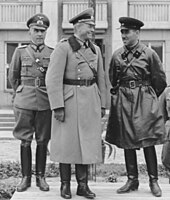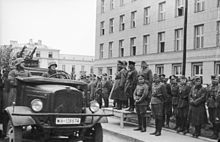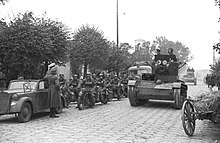Battle for the Brest Fortress (1939)
Gdansk - Westerplatte - Tucheler Heide - Krojanten - Mlawa - Radom - Wizna - Bzura - Brześć - Lemberg - Rawa Ruska - Lublin - Kampinos Heath - Warsaw - Szack - Modlin - Hel Peninsula - Kock
Situation in what was then Poland |


The battle for the strategically important fortress Brest-Litowsk (also: Siege der Fortress Brest-Litowsk) occurred as part of the attack on Poland during the Second World War between 14 and 17 September 1939 near the city of Brest-Litowsk on River bow . After three days of heavy fighting, parts of the Polish fortress garrison were able to withdraw; the rest capitulated to the German XIX. Army corps (mot.) Under General Heinz Guderian .
Preparations for the attack began on September 13 with the arrival of the first German reconnaissance units in the target area. On the same day the order to attack the Brest-Litovsk fortress was issued by General Heinz Guderian . On the morning of September 14, the first parts of the 10th Panzer Division (Reconnaissance Division and 8th Panzer Regiment) advanced into the front line in front of Brest. In order to take the fortress in a quick surprise attack, General Guderian sent the entire corps to attack. On September 15th, the ring around the city was closed from the east. An attempt to take the fortress by means of a quick tank attack failed because of the Polish Renault FT tanks placed across the fortress entrance, as the German tanks were therefore unable to penetrate inside the fortress.
In preparation for a major attack on the fortress, the German corps command post was relocated to the nearby village of Kamieniec Litewski . On September 16, the 20th Motorized Infantry Division and the 10th Panzer Division were used to attack. The fortress was supposed to be taken by storming the wall crown. This attack could be repulsed by the Polish defenders and failed with high German losses.
It was not until the morning of September 17th, the day of the Soviet invasion of eastern Poland , that the fortress could be captured when the Polish fortress garrison tried to break out over the unscathed bow bridge to the west. The fortress was taken by the 76th Infantry Regiment under Colonel Hans Gollnick .
Shortly afterwards, the first Soviet units reached Brest-Litovsk. Due to foreign policy agreements , the entire fortress area east of the Bug was to be cleared by September 22, 1939 and handed over to the Soviet Union. However, this short period was not sufficient to recover all German wounded and broken-down vehicles. Therefore, through oral negotiations in the French language spoken by General Guderian and the Soviet Brigadier General Kriwoschein , a special agreement was reached, according to which the evacuation period was extended until all German vehicles and wounded had been transported over the bow. In return, Guderian refrained from taking the Polish supplies captured in the fortress over the Bug and handed them over to the Soviet armed forces.
After the fighting ended, there was a German-Soviet military parade in Brest-Litovsk on September 22, 1939. The part of the fortress east of the bow was handed over to the Soviet Union.
literature
- Heinz Guderian: memories of a soldier. Autobiography. Original 1951. 18th edition: Motorbuch, Stuttgart, 2003, ISBN 3-87943-693-2 .
Web links
- Brześć Fortress 1921–1939 (English)



